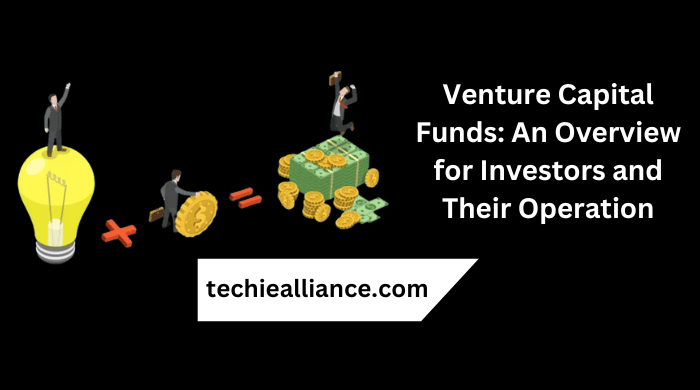Previously, only professional venture capitalists could engage in venture capital (VC); however, these days, authorized investors may participate in VC investments to a larger extent. Still, most regular investors cannot afford to participate in venture capital firms.
Venture Capital Funds: What Are They
Funds for venture capital are aggregated investment vehicles that oversee the capital of investors seeking to acquire private equity holdings in startups and small- to medium-sized businesses with promising development prospects. These investments are often classified as opportunities with very high risk and high reward.
Comprehending Venture Capital Funds

A kind of equity financing known as venture capital (VC) allows start-ups and other small businesses to obtain money even before they have launched their businesses or begun to turn a profit. Venture capital funds are investment vehicles under private equity that aim to invest in companies with high-risk/high-return profiles. This is determined by factors such as a company's size, assets, and product development stage.
The primary distinction between venture capital funds and mutual funds and hedge funds is that the former concentrate on a very particular kind of early-stage investment. All venture capital-funded businesses are high-risk, have lengthy investment horizons, and have the potential for rapid development. Venture capital firms engage in a more proactive approach to investing, offering counsel and even occupying a board position. As a result, venture capital funds actively participate in the management and day-to-day operations of the businesses in its portfolio.
The portfolio returns of venture capital firms often mimic a bell-shaped investment strategy. Many of these funds make tiny investments on a broad range of early-stage firms in the hopes that one or more will expand rapidly and provide a relatively big payoff for the fund in the end. This enables the fund to lessen the chance that certain investments may fail.
Read also:
- Origin Investments Review 2024
- Guide to Successfully Pitching for Series A, B,
- Exit Strategies Unveiled: The USA Entrepreneur's
- Capital Chronicles: The Ever-Evolving Story of Funding
Managing a Fund for Venture Capital
Depending on the stage of the firm at which the investment is made, venture capital investments are classified as seed, early, or growth capital. All venture capital funds, however, function and are governed in much the same manner, independent of the investing stage.
Prior to making any of their own investments, venture capital firms, like all other pooled investment funds, must acquire cash from other sources. Prospective fund investors get a prospectus before making a financial commitment. The fund administrators contact each prospective investor who commits, and the sums of each contribution are settled.
The venture capital fund then looks for private equity investments with the potential to provide its investors significant profits. This often means that the manager or managers of the fund go over hundreds of business plans to find firms that have the potential to expand rapidly. The expectations of the fund's investors and the mandates stated in the prospectus influence the fund managers' choices on investments. A fund typically levies an annual management fee once an investment is made; this cost typically amounts to 2% of assets under management (AUM), while certain funds may just take a proportion of returns. The general partner's expenditures and salary are partially covered by the management fees. Large fund fees may sometimes only apply to money that has been invested or decrease after a certain period of years.
Returns on Venture Capital Funds
A venture capital fund's investors get returns upon the departure of a portfolio firm via an IPO or merger and acquisition. The "2 and 20" fee agreement is a typical fee structure used in venture capital and private equity. "Twenty" denotes the normal performance or incentive fee of 20% of the fund's earnings above a certain benchmark, whereas "two" represents 2% of AUM. In addition to the yearly management charge, the fund also retains a portion of any gains realized from the exit, usually 20%.
A gross internal rate of return of around 30% is what venture capital funds generally aim for, while the exact amount depends on the sector and risk profile.
Read also: Funding Frontiers: Exploring Innovative Approaches to Exits
Venture Capital Funds & Companies
Peer-to-peer finance, biotech, and dotcom startups are just a few of the industries that venture capitalists and venture capital firms support. They often establish a fund, accept capital from other venture funds, high-net-worth individuals, and businesses looking for exposure to alternative investments, and then use that capital to invest in a variety of smaller startups known as the VC fund's portfolio firms.
More money is being raised by venture capital funds than ever before. By the end of 2019, the venture capital sector had spent a record $136.5 billion in American companies, according to financial data and software firm PitchBook.1. According to PitchBook, the year's overall number of venture capital agreements reached an all-time high of about 11,000 transactions. Two recent agreements were Instacart's $871.0 million Series F and a $1.3 billion investment round into Epic Games. Pitchbook also reported a rise in fund sizes, with the median fund size coming in at about $82 million. Eleven funds, including those from Tiger Global, Bessemer Partners, and GGV, concluded the year with commitments totaling $1 billion.
Read also: Raising the Bar: Funding Strategies and Exits Essentials

